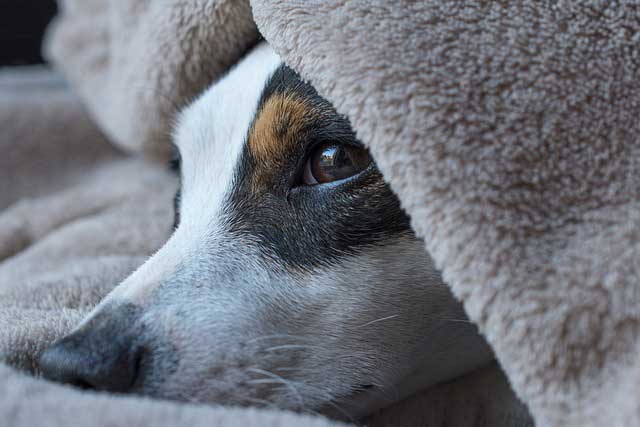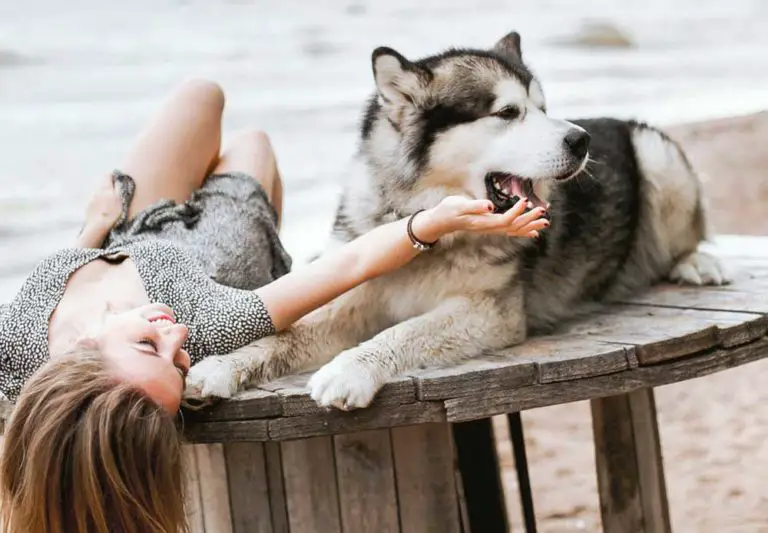Do Dogs Sleep With Their Eyes Open?
Seeing your dog lying is something gratifying, and the urge to walk in on them when asleep is almost irresistible. However, questions may begin to pop up in your mind immediately you realize that your snoring pooch is seemingly keeping a watchful eye on everything taking place around them. But do dogs sleep with their eyes open?
Yes, dogs sleep with their “eyes” open. Although it’s usually harmless, “unclosed” eyes when sleeping may be a sign of an underlying medical condition. Therefore, whether you belong to the category of pet parents who find sleeping with eyes open to be fascinating or unsettling, it’s entirely justifiable!
Why Do Dogs Sleep With Their Eyes Open?

Before we proceed any further, it’s worth noting that the “eyes” that you see when your dog is asleep aren’t the actual eyes.
When canines sleep, their third eyelids cover their real eyes. The third eyelid is technically known as the nictitating membrane or palpebra tertia.
That’s why when you take a close look at what seems to be your dog’s eyes, you will realize that they are pinkish/reddish and not exactly like your pet’s real eye color.
The nictitating membrane works well to protect and clean your dog’s eyes as well as retain moisture in your canine’s eyes. That prevents them from getting dry and itchy. Unlike humans, dogs can’t rub their eyes. Instead, they use the third eyelid to sweep off any contaminants.
According to scientists, other than protecting and cleaning your dog’s eyes when asleep, the third eyelid produces up to 50% of your dog’s tears, thanks to the nictitans gland of the nictitating membrane.
That aside, so why do dogs sleep with their “eyes” open? Well, scientists have given a few reasons for this. Firstly, it’s a defense mechanism.
By making their eyes appear open when sleeping, dogs trick anyone who comes about that they are hyper-alert. Early dogs used this ability to avert attacks by larger predators while asleep. That’s way back before they found their way to our homes.
While an attack by beasts is unlikely when at home, canines still use this ability to fool thieves that they are awake- you may not know how many times it has saved your music system and other valuables from thieves.
To some extent, the seemingly open eyes will send some signals to their brain on everything happening in their surrounding. That increases the chances of waking up in time in case of any danger.
Do All Dogs Sleep With Their Eyes Open?
Sleeping with eyes partially open is common in most animals. It happens even in humans. In fact, if stats are anything to go by, one out of every five people sleep with their eyes partly closed. That means it’s a common practice in animals.
Narrowing down to dogs, most owners claim that their canines sleep with their eyes open. What’s unclear is whether it has anything to do with age, sex, or size.
However, in some dogs, it appears more visible than in others. For instance, it’s more prominent in dolichocephalic and brachycephalic dog breeds.
Dolichocephalic dog breeds are those with long heads. Examples of these dogs are Afghan Hound, Borzoi, and Bloodhound.
On the other side, the brachycephalic dogs are those with shorter heads. Examples include bulldogs, pugs, terriers, and more. In dolichocephalic and brachycephalic dogs, the shape of the skull makes it hard to close the eyelids. That makes their third eyelid more visible when they’re sleeping.
Is It Always Harmless?
As aforementioned, most animals sleep with their eyes partly open. While that sounds a tad bit unnatural, it’s usually harmless—yes, usually! I mean, at times having your dog’s eyes remain open when sleeping may require you to call a vet.
So, when is the time to let the sleeping dog lie, and what moments should you seek the attention of a vet? Well, since it’s generally harmless, you never have to seek the intervention of a vet unless accompanied by unusual signs.
That calls for the need to occasionally monitoring your pet’s eyes for the right amount of moisture and other manifestations.
Seizure In Dogs

When having this condition, the eyes of your pup will remain open as if sleeping. That seems to make it quite hard to differentiate when your dog is sleeping and when having a seizure—right?
Fortunately, that’s not the case. You can easily differentiate a sleeping dog from one that’s experiencing a seizure.
Firstly, if your dog is asleep, he should wake up immediately once you whisper his name a few feet away. For seizures, your furry friend will not respond when you call them.
Another reliable way to differentiate the condition from normal sleeping behavior is by looking at your dog’s face. When asleep, the face looks more peaceful and relaxed.
However, a seizure manifests through tension in the face. Lastly, sleep usually involves a partial opening of the dog’s eyes. For seizures, they are wide open but with a blank stare.
Signs that your dog is having a seizure
When your dog doesn’t respond when you call and has a tensed face, it’s not wise to rule out the condition to be a seizure. Here are other signs you should look out for before you make any conclusions.
- Tongue chewing
- Foaming at the mouth
- Drooling
- Muscle twitching
- Stiffening
- Losing consciousness
- Chomping
Causes of Seizures in Dogs
There are many causes of seizures in dogs. In most cases, this condition develops from inherited disorders like Idiopathic epilepsy.
However, it may also come as a result of kidney failure, liver disease, brain tumors, strokes, anemia, diabetes, toxins, encephalitis, and more.
What Should You Do In Case Of A Seizure?
Unfortunately, when your dog begins to experience a seizure, there isn’t much you can do. It’s a condition that has to run its entire course no matter the steps you take.
The most you can do is to clear hazards to prevent your dog from injuries. After things get back to normal, it’s good to seek the attention of the vet. Where the seizure is a result of an existing medical condition, addressing the root cause may help.
Cherry Eye
Dogs don’t have any control over their third eyelid. This membrane draws across to cover the eyeball with the closure of the other two eyelids. When your dog wakes up, the third eyelid will retract back to the inner corner of the eye.
Usually, the third eye isn’t easy to see when your dog is fully awake. While it’s more visible in some dogs than in others when awake, the visibility may be a sign of a medical condition known as the Cherry eye.
Cherry eye is a condition caused by the inflammation of the tear gland of the nictitating membrane. Dogs with cherry eyes have a pink fleshy part bulging at the corner of the eye. Other signs include pawing at the eye and the inability to close it.
Since the third eyelid is overly exposed, cherry eye condition may easily attract contaminants resulting in other complicated eye-related issues. That’s why we recommend you seek vet attention immediately you suspect that your pup is suffering from this condition.
Causes of Cherry Eye
Like most dog conditions, cherry eye is congenital. However, your dog can still develop it in the course of its life. According to most pet experts, dogs under the age of two are more likely to develop the condition than the senior ones.
Also, some breeds are susceptible to the Cherry eye than others. Dog breeds such as St. Bernards, Rottweilers, Shar-peis, Beagles, Bassett Hounds, and Maltese are more likely to develop the condition compared to other dog breeds.
Over the years, the treatment of the Cherry eye condition involves surgical methods. The surgery aims at replacing the nictitans gland. When not treated, your dog will more likely begin to experience dry eyes since the condition affects tear production.
Lagophthalmos
Lagophthalmos is a condition characterized by a dog’s inability to close their eyelids fully. This disease causes dry eyes in dogs, attracting microbes. Lagophthalmos is common in dogs with shallow orbits.
Therefore, you are more likely to see it in Pugs, Pekingese, Shi Tzus, and other brachycephalic dogs. The disease may also result from facial nerve paralysis and the excessive protrusion of the eyeball caused by a mass in the eye socket.
Lagophthalmos Treatment
Treatment involves the use of lubricative ointments. Surgical shortening serves as the last resort. When left untreated, Lagophthalmos may attract a series of other eye-related conditions.
Final Thoughts
In real sense, dogs don’t sleep with their eyes open. What you see when your dog is sleeping is their third eyelid. It doesn’t affect the quality of their sleep in any way.
However, conditions like Lagophthalmos and Cherry eyes should be a real cause for alarm since they may affect your dog’s sleep and vision. That calls for the need for close monitoring of your dog’s eye condition.
You also have to know how to distinguish between a sleeping dog from one experiencing a seizure. When not treated, most of these conditions may attract more trouble.
- Why Is My Female Dog Digging – Explained!
- Why Does My Dog Scratch At Me? The Surprising Truth Revealed!
- Why Do Dachshund Dogs Dig: Uncover their Burrowing Instincts
- Why Is My Puppy Digging – Training Tips
- Why Does My Dog Keep Pawing Me?







